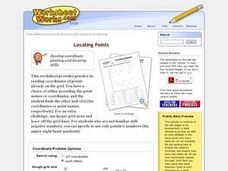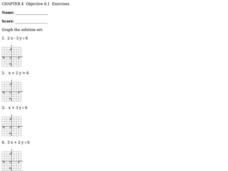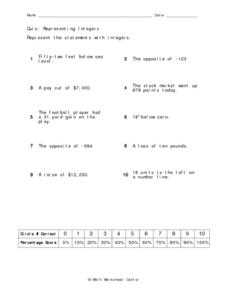Curated OER
Solving Inequalities
In this solving inequalities worksheet, students solve and complete 14 different problems that include using multiplication and division properties for inequalities. First, they state the number by which they multiply each side to solve...
Curated OER
Atoms
In this atoms activity, students circle the term in parentheses that makes the 20 statements correct. The statements review the parts of an atom, isotopes, and basic matter principles.
Curated OER
Word Problem Basics Worksheet
In this word problem basics worksheet, students read short sentences using the given clues to determine the answers to consecutive integers. Students examine terms dealing with odd integers, even integers and sum. These answers may be...
Curated OER
To Infinity: A Numbers Game
Students explore number values by participating in a class game. In this number sense lesson, students utilize dice, cards, and chess pieces to move their piece closer to the end of a number line, the point of infinity. Students answer...
Curated OER
Comparison
In this comparison activity, students solve and compare given expressions. They determine the value of terms containing exponents. This one-page activity contains 10 problems. Answers are provided.
Curated OER
Slope of a Function
Seventh graders explore the concept of the slope of a line. They see how to determine the direction of the line. Also students are introduced to the slope intercept algebraic expression in conjunction with the rise/run.
Curated OER
Exploring Atoms
In this chemistry worksheet, students complete 29 fill in the bank questions about atoms based on the movie Exploring Atoms from the website www.brainpop.com .
Curated OER
Lines of Fit
Students solve equations dealing with best fit lines. In this algebra lesson plan, students solve problems by analyzing data from a scatterplot, and define it as positive, negative or no correlation. They classify slopes the same way as...
Curated OER
Adding and Subtracting Integers
In this online interactive integers worksheet, 4th graders solve 8 addition and subtraction integer math problems and problem solve 6 integers problems involving numbers from -20 to 20. Students check their answers online when done with...
Curated OER
Locating Points
In this math worksheet, students write the coordinates of points that have been plotted on a coordinate plane. This worksheet generator allows teachers to select the size of the grid and whether or not to use negative coordinates. An...
Curated OER
Coordinate Plotting: Shapes
In this math worksheet, students graph ordered pairs on a coordinate grid. They connect the points to create a geometric shape. This worksheet generator allows teachers to select the size of the grid, the complexity of the shapes, and if...
Curated OER
Atomic Structure
Young scholars are introduced to moles and Avogadro's number, Bohr's model, Atomic emission spectra and quantum numbers. They also comprehend the current model of atoms and how electrons are described by quantum numbers.
Curated OER
Technology: Koo Koo for Clocks
Third graders design and make clocks compiling a materials list, creating adesign portfolio, and recording progress in a daily log. After making a full-size drawing of their clocks and with the assistance of high school technology...
Curated OER
Rules of Sign Change
Students manipulate negative and positive numbers. In this integers lesson, students move through three activities exploring negative and positive whole numbers. A number line, cardboard function representation, and solving expressions...
Curated OER
Additive Inverses
Students investigate properties of additive inverses. In this properties of additive inverses lesson, students discuss the what it means for two numbers to be opposites. Students discuss representing opposite numbers using a negative...
Curated OER
Can Chromatography Separate A Pigment?
High schoolers separate a mixture of pigments with ion exchange chromatography and predict whether the ion-exchange matrix is positively or negatively charged based on the type of pigment bonded to the matrix.
Curated OER
White-tailed Deer: Beauty or Beast?
High schoolers use study guides and videos to discuss the positive and negative impacts of white-tailed deer populations. In this wildlife management lesson, students view slides and discuss the natural history and value of deer as a...
Curated OER
An Ancient Disease: Who Am I?
Sixth graders research the positive and negative aspects of microorganisms noting the challenges faced by early scientists. They investigate the history of a disease of their choosing and write a summary of their findings.
Curated OER
Linear Equations
In this linear equations worksheet, students solve ten problems. The first five, they find the equation of the line that contains the given point and has the given slope. Then, for the last five, students find the equation containing...
Curated OER
Graphing Linear Equations
In this graphing worksheet, students graph ten linear equations on each of the graphs provided. They first plug in some values to the given equation using a T-chart. This will give them their coordinates to use on the graph and form...
Curated OER
Graphing Inequalities
In this graphing inequalities worksheet, students solve and graph the solution set for eight inequalities. They first solve each inequality, either for x or for y, then they plot the coordinates found on the graph provided for each...
Curated OER
Completing the Square
In this completing the square worksheet, 8th graders solve 10 different problems that include completing a square. First, they complete the square in the first 8 problems and write their solutions. Then, students determine what values to...
Curated OER
Quiz: Representing Integers
In this representing integer learning exercise, students read statements and write an integer that represents the described situation. This one-page learning exercise contains ten problems.
Concord Consortium
Integer Solutions
Experiment with integer relationships. Young scholars consider integers that have a sum of 10. They begin with two integers, then three, four, and more. As they consider each situation, they discover patterns in the possible solutions.

























